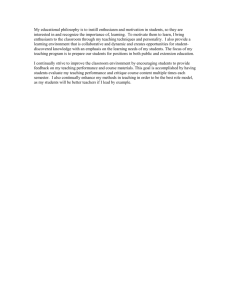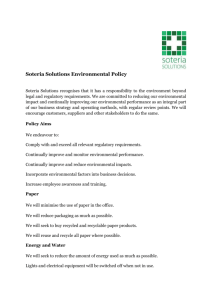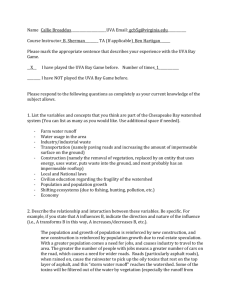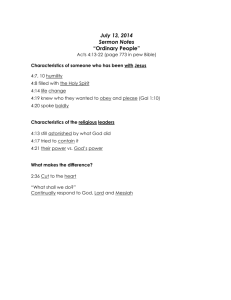IIIb IRC-GIT responses to STAC additions
advertisement
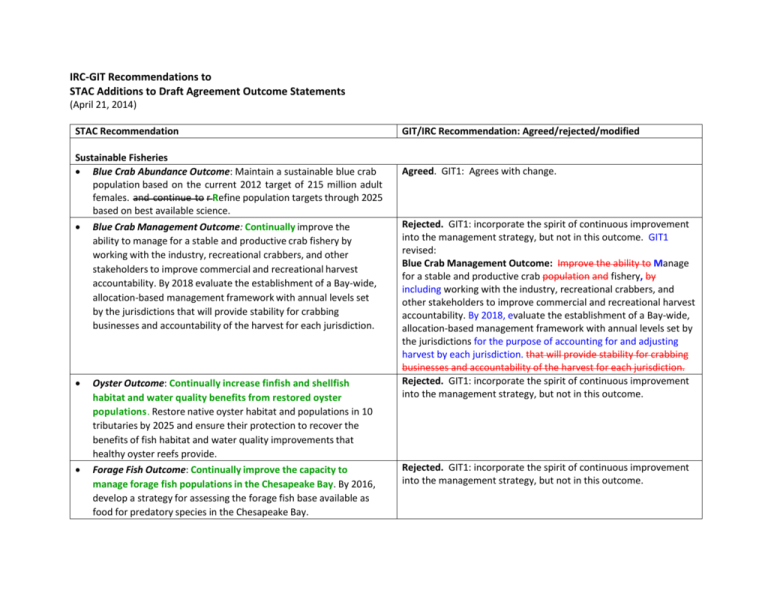
IRC-GIT Recommendations to STAC Additions to Draft Agreement Outcome Statements (April 21, 2014) STAC Recommendation Sustainable Fisheries Blue Crab Abundance Outcome: Maintain a sustainable blue crab population based on the current 2012 target of 215 million adult females. and continue to r Refine population targets through 2025 based on best available science. Blue Crab Management Outcome: Continually improve the ability to manage for a stable and productive crab fishery by working with the industry, recreational crabbers, and other stakeholders to improve commercial and recreational harvest accountability. By 2018 evaluate the establishment of a Bay-wide, allocation-based management framework with annual levels set by the jurisdictions that will provide stability for crabbing businesses and accountability of the harvest for each jurisdiction. Oyster Outcome: Continually increase finfish and shellfish habitat and water quality benefits from restored oyster populations. Restore native oyster habitat and populations in 10 tributaries by 2025 and ensure their protection to recover the benefits of fish habitat and water quality improvements that healthy oyster reefs provide. Forage Fish Outcome: Continually improve the capacity to manage forage fish populations in the Chesapeake Bay. By 2016, develop a strategy for assessing the forage fish base available as food for predatory species in the Chesapeake Bay. GIT/IRC Recommendation: Agreed/rejected/modified Agreed. GIT1: Agrees with change. Rejected. GIT1: incorporate the spirit of continuous improvement into the management strategy, but not in this outcome. GIT1 revised: Blue Crab Management Outcome: Improve the ability to Manage for a stable and productive crab population and fishery, by including working with the industry, recreational crabbers, and other stakeholders to improve commercial and recreational harvest accountability. By 2018, evaluate the establishment of a Bay-wide, allocation-based management framework with annual levels set by the jurisdictions for the purpose of accounting for and adjusting harvest by each jurisdiction. that will provide stability for crabbing businesses and accountability of the harvest for each jurisdiction. Rejected. GIT1: incorporate the spirit of continuous improvement into the management strategy, but not in this outcome. Rejected. GIT1: incorporate the spirit of continuous improvement into the management strategy, but not in this outcome. Fish Habitat Outcome: Continually improve effectiveness of fish habitat conservation and restoration efforts. Continue to identify and characterize critical spawning, nursery and forage areas within the Bay and tributaries for important fish and shellfish and use existing and new tools to integrate information and conduct assessments to inform restoration and conservation efforts. Vital Habitats Goal: Protect, restore, and enhance finfish, shellfish and other living resources, their habitats and ecological relationships to sustain all fisheries and provide for a balanced ecosystem in the watershed and Bay. Wetlands Outcome: Continually increase the capacity of wetlands to provide water quality and habitat benefits throughout the watershed. Create or re-establish 85,000 acres of tidal and non-tidal wetlands and enhance function of an additional 150,000 acres of degraded wetlands by 2025. These activities may occur in any land use (including urban) but primarily occur in agricultural or natural landscapes. Black Duck: By 2025, restore wetland habitats that enhance and preserve a wintering population of 100,000 black duck, a species representative of the health of tidal marshes across the watershed. Refine population targets through 2025 based on best available science. (This is clearly a management target that should fit under the preceding Wetlands Outcome.) Stream Health Outcome: Continually improve stream health and function throughout the watershed. Improve health and function of 10% of stream miles above the 2008 baseline for the Chesapeake watershed. Note: a 2008 baseline will be established by 2015. Rejected. GIT1: incorporate the spirit of continuous improvement into the management strategy, but not in this outcome. Rejected. GIT2: would agree to inserting “Continue to” at beginning of goal statement , but only if similar change is made to all other goals. Rejected. GIT2: incorporate the spirit of continuous improvement into the management strategy, but not in this outcome. Accepted. GIT2: Agrees with part of STAC change: “Black Duck: By 2025, restore wetland habitats that enhance and preserve a wintering population of 100,000 black duck, a species representative of the health of tidal marshes across the watershed. Refine population targets through 2025 based on best available science.” Rejected. GIT2: incorporate the spirit of continuous improvement into the management strategy, but not in this outcome. Brook Trout: Restore and sustain naturally reproducing brook trout populations in Chesapeake headwater streams with an 8 percent increase in occupied habitat by 2025. . (This is clearly a management target that should fit under the preceding Stream Health Outcome.) Fish Passage Outcome: Continually increase the sustained presence of alewife, blueback herring, American shad, hickory shad, American eel, and brook trout in Chesapeake Bay freshwater rivers and streams. By 2025, restore historical fish migratory routes by opening 1,000 additional stream miles, with restoration success indicated by the presence of alewife, blueback herring, American shad, hickory shad, American eel and/or brook trout. (2011 baseline year) Submerged Aquatic Vegetation (SAV) Outcome: Sustain and increase the water quality and habitat benefits of SAV in the Chesapeake Bay. Achieve and sustain the ultimate outcome target of 185,000 acres of SAV Bay-wide necessary for a restored Bay. Progress towards this ultimate outcome will be measured against a target goal of 90,000 acres by 2017 and 130,000 acres by 2025. Rejected. GIT2: incorporate the spirit of continuous improvement into the management strategy, but not in this outcome. Forest Buffer Outcome: Continually increase the capacity of forest buffers to provide water quality and habitat benefits throughout the watershed. Restore 900 miles per year of riparian forest buffer and conserve existing buffers until at least 70% of riparian areas throughout the watershed are forested. Rejected. GIT2: incorporate the spirit of continuous improvement into the management strategy, but not in this outcome. Urban Tree Canopy Outcome: Continually increase the capacity of urban tree canopy to provide air quality, water quality, and habitat benefits throughout the watershed. Expand urban tree canopy by 2,400 acres by 2025. Rejected. GIT2: incorporate the spirit of continuous improvement into the management strategy, but not in this outcome. Water Quality – no changes recommended by STAC Rejected. GIT2: incorporate the spirit of continuous improvement into the management strategy, but not in this outcome. Modified. GIT2: Agrees with part of STAC change: “[SAV] Outcome: “Achieve and sustain the ultimate outcome of 185,000 acres of SAV Bay-wide necessary for a restored Bay. Progress towards this ultimate outcome will be measured against a target goal of 90,000 acres by 2017 and 130,000 acres by 2025.” Healthy Watersheds Healthy Waters Outcome: 100% of state-identified currently healthy waters and watersheds remain healthy. (?) (We are unable to structure this to reflect the desired positive change to the Bay watershed resulting from this outcome. We suggest the following outcomes as a substitute or addition). Tracking Healthy Watersheds Methods and Metrics Development Outcome: Continually improve the information available for identification and assessment of healthy watersheds in the Chesapeake Bay watershed. By 2016, develop a Chesapeake Bay watershed-wide methodology and local-level metrics for characterizing healthy watersheds, and assessing their vulnerabilities. Local Engagement Outcome: Continually improve the capacity of local governments to track and manage healthy watersheds. By 2016, launch a public awareness campaign to assist local governments or their representatives in their efforts to strategically track, manage, and continually increase the number of healthy watersheds in their localities. Land Conservation Protected Lands Outcome: Improved protection of lands important for provision of water quality and habitat benefits. By 2025, protect an additional two million acres of lands throughout the watershed currently identified as high-conservation priorities at the federal, state or local level, including 225,000 acres of wetlands and 695,000 acres of forest land of highest value for maintaining water quality. (2010 baseline year) Rejected. GTI4: these will be addressed during management strategy development Rejected. GTI4: these will be addressed during management strategy development Rejected. GTI4: these will be addressed during management strategy development Rejected. GIT5: STAC language is not reflective of the full intent of the protected lands outcome and is already described in the goal statement. Land Use Methods and Metrics Development Outcome: Continually improve the knowledge of land conversion and the associated impacts throughout the watershed. By 2016, develop a Chesapeake Bay watershed-wide methodology and local-level metrics for characterizing the rate of farmland, forest, and wetland conversion, measuring the extent and rate of change in impervious surface coverage and quantifying the potential impacts of land conversion to water quality, healthy watersheds, and communities. Launch a public awareness campaign to share this information with local governments, elected officials, and stakeholders. Land Use Options Evaluation Outcome: Continually improve the capacity of local governments to track and manage land use conversions. By 2017, with the direct involvement of local governments or their representatives, evaluate policy options, incentives, and planning tools that could assist local governments in their efforts to strategically track, manage, and reduce the rate of consumption of agricultural lands, forests and wetlands, and the rate of conversion of porous landscapes to impervious surfaces, and develop an outcome for achieving those reductions by 2025. Public Access Public Access Site Development Outcome: Continually increase public use of the Bay and its rivers and streams for boating, swimming, and fishing. By 2025, add 300 new public-access sites, with a strong emphasis on providing opportunities for boating, swimming and fishing, where feasible. (2010 baseline year) Accepted. IRC recommended: Land Use Methods and Metrics Development Outcome: Continually improve the knowledge of land conversion and the associated impacts throughout the watershed. By 2016… Modified. IRC recommended: Land Use Options Evaluation Outcome: Continually improve the capacity of local governments to reduce land use conversions. By 2017, with the direct involvement of local governments or their representatives, evaluate policy options, incentives, and planning tools that could assist local governments in their efforts to strategically track, manage, and reduce the rate of consumption conversion of wetlands, and agricultural and forest lands and the rate of conversion of porous landscapes to impervious surfaces., and Develop an outcome strategies for supporting local governments’ and other efforts in achieving those reductions by 2025 and beyond. Rejected. GIT5: STAC’s suggested language is repetitive of the current outcome language. Environmental Literacy Meaningful Watershed Educational Experience Outcome: Continually increase the number of students participating in teacher-supported meaningful watershed educational experiences in elementary, middle and high school. School and School System Model Development Outcome: Steadily increasing support for and recognition highlight models of sustainable schools and local education agencies that use system-wide approaches for environmental education. Environmental Literacy Metrics Outcome: By 2014, develop baseline metrics to establish and measure outcomes related to student participation in teacher-supported meaningful watershed educational experiences and related activities. (This is effectively a strategy for accomplishing/monitoring the Meaningful Watershed Educational Experience Outcome above. Consider moving it there.) Toxic Contaminants Toxic Contaminants Research Outcome: Continually increase our understanding of the types, sources, impacts, and mitigation options for contaminants affecting the biota and human uses of the Bay and its watershed. By 2015, develop a research agenda and further characterize the occurrence, concentrations, sources Modified. GIT and IRC Recommended: Student Outcome: Continually increase the number of students participating Every student participates in at least one teachersupported meaningful watershed educational experience in elementary, middle, and high school. By 2014, develop baseline metrics to establish and measure outcomes related to student participation in teacher supported meaningful watershed educational experiences and related activities. Modified. GIT and IRC Recommended: Sustainable Schools Outcome: Continually increase the number of schools in the region working All schools in the region work towards maintaining their buildings, grounds, and operations using best practices to support environmental and human health and maximize student involvement. Modified. GIT and IRC Recommended: Environmental Literacy Plan Metrics Outcome: Steadily increase support for and recognition of sustainable schools and local education agencies that use system-wide approaches for environmental education. By 2016, all states complete an environmental literacy plan that details system wide approaches for environmental education to meet the provisions of this agreement. Modified. IRC recommended: Toxic Contaminants Research Outcome: Continually increase our understanding of the impacts and mitigation options for toxic contaminants. Develop a research agenda and further characterize the occurrence, concentrations, sources and effects of mercury, PCBs and other contaminants of emerging and widespread concern. and effects of mercury, PCBs and other contaminants of emerging and widespread concern. In addition, identify which BMPs might provide a dual multiple benefit of reducing nutrient and sediment pollution as well as toxic contaminants in waterways. Toxic Contaminants Policy and Prevention Outcome: Continually improve the efficacy of policies and prevention strategies for toxic contaminants. By evaluate the implementation of existing programs, policies, and practices, and additional policies, programs, and practices informed by the Toxics Contaminants Research Outcome as needed, to further reduce or eliminate loadings of persistent bioaccumulative and toxic contaminants (PBT) and non-PBT contaminants to prevent harm to fish, wildlife, and citizens of the region. Changing Environmental Conditions Resilient Restoration Outcome: Continually improve the effectiveness of Implement effective Bay restoration in the face of sea level rise and changing environmental and climate conditions. Monitoring and Assessment Outcome: Continually improve the effectiveness of Support monitoring activities to deliver routine and sustained climate science, information products and services. In addition, identify which BMPs might provide a dual multiple benefits of reducing nutrient and sediment pollution as well as toxic contaminants in waterways. Modified. IRC recommended: Toxic Contaminants Policy and Prevention Outcome: Continually improve practices and controls that reduce and prevent the effects of toxic contaminants below levels that harm aquatic systems and humans. Build from existing programs to reduce the amount, and effects, of PCBs in the Bay and watershed. Use research findings to evaluate the implementation of additional policies, programs, practices for other contaminants that need to be further reduced or eliminated. Modified. IRC recommended: Adaptation Outcome: Continually pursue, design, and construct restoration and protection projects to enhance the resiliency of bay and aquatic ecosystems from the impacts of coastal erosion, coastal flooding, more intense and more frequent storms and sea level rise. Modified. IRC recommended: Monitoring and Assessment Outcome: Continually monitor and assess the trends and likely impacts of changing climatic and sea level conditions on the Chesapeake Bay ecosystem, including the effectiveness of restoration and protection policies, programs and projects. By 2017, complete a study of best management practices commonly employed to control nutrient and sediment runoff and consider necessary management adjustments. Stewardship Citizen Stewardship Outcome: Continually increase the number [and diversity] of trained and mobilized citizen volunteers with the knowledge and skills needed to enhance the health of their local watersheds. Stewardship Metrics Outcome: By 2015, work with Chesapeake Bay Program partners and other wide ranging academic, local government and citizen organizations to develop a metric for evaluating progress in citizen stewardship. (This is clearly a management strategy for accomplishment/monitoring of the preceding Citizen Stewardship Outcome. Consider moving it there.) REVISITED OUTCOMES Local Leadership Outcome: Continually increase Engage, empower, and facilitate leadership by local governments and increase the number of local governments that have implementationed of innovative financing strategies to meet agreement goals (2010 Baseline year). Diversity Outcome: Continually increase opportunities and programs to recruit and engage identify minority stakeholder groups who are not currently represented in the leadership, decision-making and implementation of the current conservation and restoration. activities and create meaningful opportunities and programs to recruit and engage them in the Partnership. Water Quality Standards Attainment Outcome: Continually improve the Partnership’s capacity to assess the consequences of management actions throughout the Bay watershed. By the end of 2015 establish an outcome, based on monitoring data and sound science, that projects a science-based estimation of the Modified. IRC recommended: Citizen Stewardship Outcome: Increase the number [and diversity] of trained and mobilized citizen volunteers with the knowledge and skills needed to enhance the health of their local watersheds. Modified. IRC recommended: Local Leadership Outcome: Continually increase the knowledge and capacity of local officials on issues related to water resources and in the implementation of economic and policy incentives that will support local conservation actions. Rejected. IRC recommended: Diversity Outcome: Identify minority stakeholder groups who are not currently represented in the leadership, decision making and implementation of the current conservation and restoration activities and create meaningful opportunities and programs to recruit and engage them in the partnership. Modified. IRC recommended: Water Quality Standards Attainment and Monitoring Outcome: Continually improve the capacity to monitor and assess the effects of management actions being undertaken to implement the Bay TMDL and improve water quality. Use the monitoring results to report annually to the public on progress made in attaining percentage of Bay segments that will meet water quality standards by 2025. established Bay water-quality standards and trends in reducing nutrients and sediment in the watershed.
